Abstract
Streptocarpus formosus (Hilliard & B.L. Burtt) T.J. Edwards is a flowering herbaceous perennial indigenous to South Africa and is part of the rosulate group of herbaceous acaulescent plants within the Gesneriaceae family. According to the National Assessment database for the Red List of South African Plants version 2020.1., the plant is listed as rare. The ornamental use of S. formosus has untapped commercial potential as a flowering indoor pot plant, an outdoor bedding plant for shade and as a cut flower for the vase, all of which are limited by a five-month eco-dormancy period during the late autumn and all through the cold season in the short-day winter months. Viable commercial production will require cultivation techniques that produce flowering plants all year round. This study investigated the effectiveness of applying root zone heating to S. formosus plants grown in deep water culture hydroponics during the eco-dormancy period in preventing abscission layer formation and in encouraging flowering and assessed the growth activity response of the plants. The experiment was conducted over eight weeks during the winter season in the greenhouse at Kirstenbosch Botanical garden in water reservoirs, each maintained at five different experimental temperature treatments (18, 22, 26—control, 30 and 34 °C) applied to 10 sample replicates. The results showed that the lowest hydroponic root zone temperature of 18 °C had the greatest effect on the vegetative growth of S. formosus, with the highest average increases in fresh weight (1078 g), root length (211 cm), overall leaf length (362 cm) and the number of newly leaves formed (177 = n), all noted as statistically significant when compared with the other water temperature treatments, which yielded negative results from reduced vegetative growth. Findings from the study also revealed that while all heated solutions significantly prevented the formation of abscission layers of S. formosus, they had a less significant effect on inflorescence formation, with only 18 °C having the greatest positive effect on flower development.
1. Introduction
Within the Gesneriaceae, Streptocarpus form part of an economically important ornamental plant group with other significant members such as Saintpaulia spp. (African Violets), Gloxinia spp. and Sinningia spp. [1], all of which are herbaceous perennials known for the beauty of their flowers [2,3]. In its wild habitat in the Eastern Cape province of South Africa, Streptocarpus formosus flowers only in long-day, warm, summer months of the year [1,4]. S. formosus grows naturally in a summer rainfall locality with very little irrigation through precipitation during the cold season [4]. This abiotic combination of reduced water and low temperatures triggers a survival tactic where the nutrients and carbohydrate reserves in the leaves are transported and remobilized to actively growing parts of the plant causing yellowing of the part, or all, of the leaves [5,6] before the plants enter a survival state of eco-dormancy [7].
This annual process in Streptocarpus with flowering occurring mostly under 15 h long days as compared to 8 h short days [8] and combined with the slowed short-day growth processes of eco-dormancy and the shedding of leaf mass through unsightly abscission layers severely limits the ornamental commercial use of Streptocarpus formosus. Therefore, cultivation methods to keep plants looking attractive in active growth and to extend the flowering season are required [8,9]. The manipulation of flowering is an important aspect of the cultivation of many horticultural crops [10]. There is a high demand for flowering pot plants during all seasons, even in winter when temperatures are below optimum for flower production [11] and annual plant senescence due to low temperature causes yield reduction that results in significant economic losses to growers [12,13,14]. Root temperature is one of the key environmental factors that control plant growth and physiological activities in cold seasons [15,16]. Manipulating root zone temperature to keep plant crops and ornamentals actively growing for commercial out-of-season production has been comprehensively researched purposely to meet market demands [17,18,19,20].
Growth cessation, abscission formation and dormancy development, all of which are exhibited by S. formosus, are considerably affected by temperature [21]. Leaf loss is a physiological strategy for the avoidance of water stress in plant species adapted to drought, reducing the transpiring surface of the foliage and thereby lessening water demand [21,22]. However, leaf senescence is mainly caused by cold and less commonly by high temperature [5,23]. In Streptocarpus formosus with no predetermined abscission zone, leaves are either shed entirely or a 2–3 mm wide demarcation line [24] forms on the leaves and a visible difference between the basal and distal sections of the lamina is distinguishable with a dark green base and a bright yellow upper section [25]. This partial senescence in Streptocarpus is a perennation mechanism that ensures the protection of the basal meristem [24,26]. When the distal leaf section is completely brown and dry, this part breaks away cleanly along the abscission layer [27,28] and the leaf can continue to lengthen with new growth from the base [3,27].
The chlorophyll content is an important criterion when evaluating the ornamental value of a pot plant [29]. The degradation of chlorophyll is the cause of leaf yellowing during senescence [28,30,31]. Various studies have shown the positive effect of heated water on the retention of chlorophyll and the increased amount present within leaves [11,16,32]. The optimum temperature of the growth medium can contribute beneficially to plant physiological processes such as chlorophyll pigment formation, the accumulation of phenolic compounds and an increase in photosynthetic capacity [11].
Heat is required to increase growth to expand plant production during the cold season and can be provided with the use of greenhouses [30], and it can be combined with hydroponic growing which has become common practice to improve winter yields and to obtain optimum production under periods of suboptimal climatic conditions [11,31]. Additional benefits of heating the nutrient solution are the provision of the energy requirements for plant development, activating metabolism [32] and a reduction in pathogenic activity [33]. The application of root zone heating in a closed hydroponic system enables the volume of water to buffer temperature and contributes to energy savings compared with the expense of heating entire greenhouse structures [11,33]. With a notable global increase in the scarcity of resources and climate change, hydroponics offers workable solutions by achieving optimal growth yield and good quality crops due to the precise control of nutrition and growing conditions [17,34,35]. Yields in hydroponics average at 20–25% higher than in conventional soil cultivation and have demonstrated significantly more growth and development in root systems, which also improves the nutrient uptake ability of the plants which, in turn, leads to better shoot and leaf growth [34].
This study was designed to investigate the possibility of achieving optimum growth during the winter season by determining how the application of root zone heat could viably facilitate the ornamental production of S. formosus, and to evaluate the effects of different regimes of root zone temperature on abscission layers activated by eco-dormancy and the earlier formation of S. formosus flowers. It was also envisaged that this study would assist in determining an optimal temperature for the active growth and inflorescence formation of S. formosus to produce consistently high vegetative growth and flowers for cultivating superior quality pot plants in hydroponics to benefit the ornamental and floriculture industries.
2. Materials and Methods
2.1. Greenhouse Experiment
The experiment was conducted over 8 weeks during winter in the greenhouse facility at the Kirstenbosch National Botanical Garden (KNBG), Cape Town, South Africa (33°98′ 56.12″ S, 18°43′ 60.25″ E) from mid-June 2019 to mid-August 2019. Plants were grown under natural daylight conditions which provided the short-day photoperiod, 9:59:26 hr day length (15th June) to 10:54:49 hr day length (15th August), required for the experiment as S. formosus is then in the eco-dormancy period of its annual vegetative growth [1]. An overhead Aluminet shade net screen provided 40% shading and minimized temperature fluctuations. Maximum day temperatures ranged between 13 °C and 18 °C and night temperatures between 3 °C and 7.8 °C, with an average relative humidity between 77 and 81%.
2.2. Plant Preparation
Fifty genetically identical S. formosus plantlets were propagated vegetatively (Figure 1a) from one S. formosus mother plant. After the rooting period of four months (Figure 1b), the plantlets were thoroughly rinsed to remove the rooting media and all foreign matter from their leaves and roots. They were then potted into lattice-net plastic pots filled with 4–10 mm lightweight expanded clay aggregate (LECA) and placed in the hydroponic system with only their roots submerged in water. LECA was the preferred soilless growth medium for this study because its lightweight properties, with added porosity, would not degrade in the water while its pH remained neutral with the additional advantage of protecting the roots with its thermal insulation properties [36].
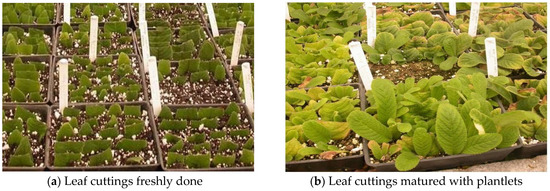
Figure 1.
Leaf cuttings of S. formosus provided n = 50 plants cultivated from one initial mother plant obtained from Kirstenbosch National Botanical Garden, Cape Town (Photos: C. Viljoen).
2.3. Hydroponic Cultivation
A closed deep water hydroponic system with an air stone and a circulating pump was used based on the recommendations, discussions and methodologies of [11,37,38]. Deepwater hydroponics allows for methods of heating the nutrient solution to the required temperature and maintains a consistent nutrient supply and temperature over the entire root surface area of the replicates. Closed hydroponics systems allow for the reuse of nutrient solution, reducing the negative environmental impacts such as leaching of fertilizers, soil and groundwater pollution, and water wastage while saving on labor. LECA provided support for the plants needing to be suspended in the nutrient solution while providing excellent aeration qualities [11,36].
Five identical deep water hydroponic systems were constructed and placed onto wire mesh tables. Each system consisted of one 70 L capacity low-density polyethylene (LDPE) reservoir filled with 60 L of aqueous nutrient solution. Each reservoir was covered with an LDPE sheet into which holes were cut to hold the 10 lattice-net (7.5 cm) plastic pots suspended (Figure 2). The pot size and depth ensured that the root zones of the plants were submerged in the nutrient solution without wetting the plant’s leaf crowns, avoiding possible crown rot. To prevent oxygen deficiency and the limitations this would place on the plant growth, root aeration is essential in a hydroponic system, especially in deep water culture where there is limited air-water exchange capacity and particularly when heating the solution as there is a direct correlation between the temperature of water and the amount of oxygen it contains [35,39]. As water temperature increases, less oxygen becomes available to the roots [40], so to increase aeration all the solutions were aerated using one electromagnetic air compressor (BOYU ACQ-003) linked to each system’s single air stone (50 mm), which bubbled the air up through the nutrient solution at a rate of 50 L per minute, supplying oxygen to the roots of the plants. To assist with the even distribution of both the additional air (O2) and the heated water [37], each system’s solutions were circulated using an 800 L/h hour HT submersible pump (HJ-941).
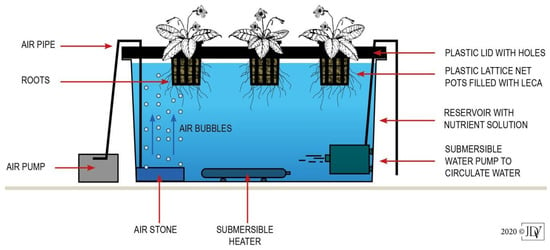
Figure 2.
The closed hydroponic deep water culture system used for this study with air stone and circulating pump, and plants in lattice-net pots filled with LECA aggregate held suspended in nutrient solution (Diagram by J.D. Viljoen).
The solution comprised of ozone-treated borehole water containing Nutrifeed at a dilution rate of 1:500 (120 g in 60 L), as specified by the manufacturer Starke Ayres Pty. Ltd. Hartebeefontein Farm, Bredell Rd, Kaalfontein, Kempton Park, Gauteng, 1619, South Africa. This nutrient product supplied all the essential macro and micronutrients (6.5% Nitrogen, (N), 2.7% Phosphorous (P), 13.0% Potassium (K), 7.0% Calcium (Ca), 2.2% Magnesium (Mg), 7.5% Sulphur (S), plus Iron, Manganese, Boron, Zinc, Copper and Molybdenum) required for healthy plant growth as hydro-soluble fertilizer salts [38]. As the experiment would fall within a two-month growth period, it was decided that replacing the nutrient solution to overcome the build-up of phototoxic substances in the nutrient solution would not be required, to prevent potential disturbance damage to the roots [41,42].
The pH levels of all the nutrient solutions were monitored biweekly using a calibrated hand-held digital pH meter (HM Digital PS PH-200) and kept within a range of 6.4–7.0, a slightly acidic level recommended by [43]. The pH was adjusted accordingly using either sodium hydroxide (NaOH) to raise the pH, or hydrochloric acid (HCL) to lower the pH [42]. The various temperatures of the five test solutions were also measured for monitoring consistency. The electrical conductivity (EC) level of each system was kept within a 0.9–1.1 dSm-1 range as suggested for Streptocarpus by [44] and was used as a measure of the nutrient concentration of the solution. The EC levels and temperatures of all the nutrient solutions were monitored biweekly using a calibrated handheld (PS COM-100) EC and temperature meter produced by HM Digital Inc., Culver City, CA, USA 90230. For decreasing the EC of aqueous nutrient solutions, ozone-treated borehole water was added into reservoirs, while adding 1:500 diluted Nutrifeed™ solution increased EC levels.
2.4. Water Temperature Treatments and Experimental Design
The experiment consisted of five different hydroponic solution temperatures which were applied to 50 plants of S. formosus using a completely randomized block design (Figure 3; Table 1). Each temperature treatment consisted of 5 treatments with 10 replicates (n = 10), one per pot suspended in a closed deep water culture system. Pots were individually numbered and arranged randomly. The five test solutions were heated using submersible EHEIM (Plochinger Str. 54 73779 Deizisau, Germany) thermo control manually adjustable heaters as standard aquarium equipment.
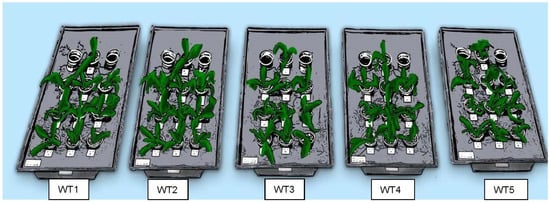
Figure 3.
A completely randomized experimental block design used for the investigation (Diagram: J.D. Viljoen).

Table 1.
Water temperature treatments and temperature ranges.
The water temperature range applied was based on the ideal temperature recommendations for growing Streptocarpus [45], Gesneriad Sinningia cardinalis, [46] and other perennials [11,16], which were proven beneficial to both vegetative and inflorescence development in each case. The mean annual temperature at Port St Johns, which is S. formosus’ natural habitat, is 19.9 °C as recorded between 1961 and 1990, with a mean summer min-max of 17.1 °C–27.6 °C when the plants are in full growth and flowering, as opposed to the mean winter min-max of 7.4 °C–20.5 °C when the plants are eco-dormant [47]. This experiment focused on applying a similar summer temperature range to the root zone to test whether the plants could thus be stimulated into active growth and flowering during the colder winter months, and WT3 at 26 °C was selected for the control as the literature reviewed indicated this to be both the ideal ambient air temperature for Streptocarpus under non-experimental circumstances, and a common root zone median temperature for root to shoot ratios under experimental conditions for a selection of perennial crops [11,16,32,48,49].
2.5. Vegetative Growth and Data Collection
Various measurements were taken to determine plant growth response to different nutrient solution temperatures on leaf quantity, leaf lengths, root lengths and fresh weights. Data capturing took place pre-planting and at the time of planting the plants into the quantitative research experiment system, and again post-harvest after a two-month growth period.
Before planting, each entire plantlet (roots and shoots together) was weighed for a fresh wet measurement, using an electronic laboratory scale (Sartorius Analytical Balance Scale Model type 1518) with 0.001 g readability. Additionally, at this time the lengths of both the shortest and longest leaves, as well as root length for each plantlet, were measured using a ruler [50] and recorded. The measurement of leaves was taken from the growth media level to the apex point of each leaf. All present and emerging leaves were measured, but not if less than 2 mm in length. The root length of each plant was measured by the points at which roots emerged from the stem to the tip of the root mass. Immediately after being transplanted into the LECA filled pots and placed in the deep water culture solutions, the total number of present and emerging leaves on each plantlet was then counted, but not if less than 2 mm in length, and recorded. At post-harvest, these same measurements were repeated, and the data recorded.
2.6. Inflorescence Data Collection
Immediately after being transplanted into the LECA filled pots and placed in the hydroponic test solutions, measurement of various floral parts was performed. The numbers of inflorescence stalks per plant were counted and recorded, including all present and emerging pedicels, but not if less than 2 mm in length, and the numbers of flower buds and flowers per plant were counted and recorded. After a two-month growth period, at post-harvest, these same counts were repeated and the data recorded and analyzed to determine inflorescence development in response to different nutrient solution temperatures.
2.7. Eco-Dormancy Data Collection
Immediately after being transplanted into the LECA filled pots and placed in the hydroponic test solutions, the number of abscission layers present in the leaves per plant was counted and recorded. At post-harvest, the presence or absence of abscission layers was recounted and the data recorded.
2.8. Statistical Analysis
All data collected were statistically analyzed using one-way analysis of variance (ANOVA) and computed by the software program TIBC STATISTICA Version 13.6.0. The ANOVA test was used to determine if there was a statistically significant difference between each group of water temperature’s mean value. A within-between ANOVA mixed model was applied to examine for potential differences in a continuous level variable between the treatment and the control group, and over time with pre and post-tests. The occurrence of statistical difference was determined by using the Fisher Protected Least Significance Difference (L.S.D.), a pair-wise comparison technique for the comparison of two means, at values of p < 0.05; p < 0.01 and p < 0.001 levels of significance [51].
3. Results
3.1. Total Leaf Number
There was an interaction between hydroponic root zone temperature and the final numbers of leaves produced by the plants. The increase in the number of leaves was highly significant (F1,4 = 34.27, p ≤ 0.0001), and the WT1 (18 °C) treatment showed a greater increase in leaves compared to the control WT3 (26 °C) treatment by week 8 of the experiment (Table 2). The greatest increase in leaf numbers occurred at the lowest temperature treatment 18 °C, with a mean of 17.7 when compared to the 26 °C control with a mean of 6.7. Leaf numbers also displayed notably poorer results in WT2 (22 °C), mean 13.3, and WT4 (30 °C), mean 3.3. WT5 (34 °C) resulted in almost complete leaf fatality.

Table 2.
The interaction of various root zone water temperatures on the overall vegetative growth of S. formosus.
3.2. Total Leaf Length
There was an interaction between root zone water temperature and final leaf length produced by the plants with a highly significant F-statistic (F1,4 = 49.02, p ≤ 0.0001). The 18 °C (WT1) treatment with a mean of 36.22 cm had the highest reading compared to the control 26 °C (WT3) treatment, mean 6.68 cm, or any of the other treatments by the final 8th week of the experiment (Table 2). There was thus a significant reduction in the rate of leaf length development at both WT2 22 °C (15.85 cm) and WT3 (6.68 cm), with a further reductive loss in leaf length in WT4 30 °C (−2.18 cm). This sharp decline was visually observed in the leaf health, quality and length, as temperature increases to 34 °C (WT5) compared to the control WT1 of 18 °C (Figure 4) yielded the largest increase in leaf length.
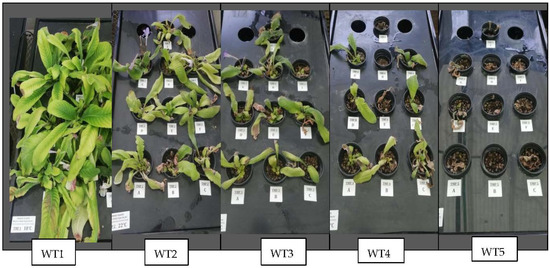
Figure 4.
The visible effect of the escalating hydroponic root zone temperatures on the vegetative aerial parts of S. formosus evident through simple observation over the experimental period with a directly proportional reduction in leaf numbers and lengths at increasingly higher temperatures (Photos: C. Viljoen).
3.3. Total Root Growth
The statistical analysis in Table 2 indicates the greater significant values (F1,4 = 69.63, p ≤ 0.0001) with root growth than with the aerial parts of the plant, and indicates that WT1 (18 °C) demonstrated a notable 210.5 cm overall increase in root length, compared with only 4.5 cm at WT2 (22 °C), versus the overall negative growths of −5.4 cm for the control WT3 (26 °C) and −23.3 cm at WT4 (30 °C) treatment, with the complete death of the roots at WT5 (34 °C) treatment. Figure 5 presents the treatment interaction effect on the total root growth of the S. formosus plants and it indicates that heat in the root zone is a severely limiting factor when heating above a critical temperature range. Root zone temperatures at 22 °C resulted in poor root development and all the temperatures above resulted in no development and sharply declining growth or death of the S. formosus plant’s root system.
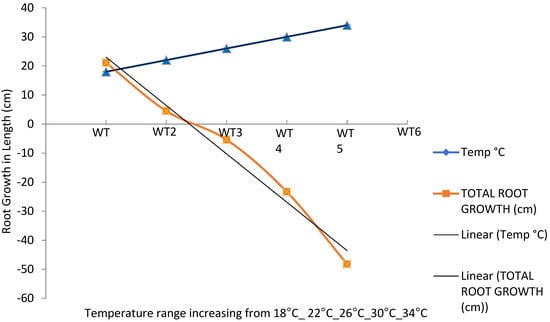
Figure 5.
The relationship between root zone water temperature treatments and the relative rates of increase and decrease in root length.
3.4. Total Fresh Weight
Combined root and leaf fresh weights, as shown statistically in Table 2, were significantly affected by the root zone temperature (F1,4 = 23.75, p ≤ 0.0001), and the results show that incremental increases in water temperature treatments from 18 °C to 34 °C decreased fresh weight, to the point of notable fatality at the highest temperatures of 30 °C and 34 °C, clearly visible in Figure 4. The WT1 (18 °C) treatment offered the highest significant increase in overall fresh weight and vegetative growth when compared to the control WT3 (26 °C) and all the other treatments: WT2 (22 °C), WT4 (30 °C) and WT5 (34 °C). Findings from this study established that increasing hydroponic root zone solution temperature beyond the 18 °C–20 °C range did not promote the overall growth and development of S. formosus when compared with the significant increase in biomass growth in WT1, 18 °C, yielding a total of 107.90 g, which is equivalent to a 400% increase over 8 weeks.
3.5. Flowering in Response to Five Different Temperature Regimes in Hydroponics
The interaction between root zone heating and the inflorescence development of S. formosus was found to be statistically significant (Table 3), in the flower and bud formation (F1,4 = 4.72, p ≤ 0.01) as well as the pedicel development (F1,4 = 4.72, p ≤ 0.001). The highest individual mean value was evident in treatment WT1 18 °C (Figure 6); both for numbers of flowers and buds (mean 2.5) and the number of pedicels (mean 5), indicating that higher root zone temperatures WT2 (22 °C), WT3 (26 °C), WT4 (30 °C) and WT5 (34 °C) incrementally decreased inflorescence formation.

Table 3.
The effect of various root zone water temperatures on the total flower development of S. formosus.
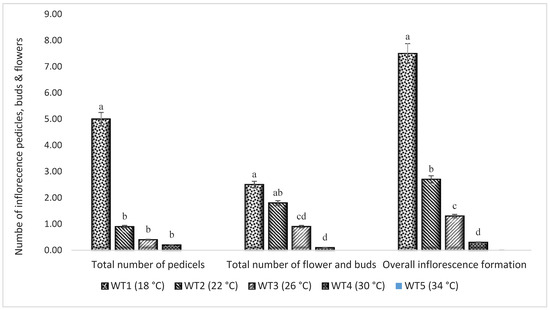
Figure 6.
The relationship between root zone water temperatures and inflorescence formation. Note: The bars presented here are means ± SE. Bars with different letters are significantly different at p ≤ 0.01 (**) (total number of flower and buds; overall inflorescence formation) and p ≤ 0.001 (***) for the total number of pedicels as calculated by Fisher’s least significant difference.
Conversely, the lowest temperature of 18 °C (WT1) significantly increased the inflorescence formation of S. formosus. Flowers were evident at lower root zone temperatures of 18 °C and 22 °C compared to the control treatment at 26 °C (WT3) or the higher temperatures. Increasing water temperature in the range from 26 °C to 34 °C not only decreased inflorescence formation but led to total fatality of the plants at the highest temperature of 34 °C (WT5), as seen in Figure 6. A positive finding is that at 18 °C (WT1) flowers did develop during colder short-day periods, which indicates a strong possibility that manipulating the growing temperatures could induce S. formosus to flower earlier in the season, thereby extending the flowering period for an all-round year commercial marketing period.
3.6. Reduction in Abscission Layers in Response to Five Different Temperature Regimes in Hydroponics
As shown in Figure 7, the effects of root zone water temperature on the reduction in abscission layers already present on the S. formosus replicates’ leaves were statistically significant at a value (F1,4 = 19.85, p < 0.0005). The few abscission layers that were present at the time of the experiment’s inception all disappeared (Figure 8); however, more significantly, no abscission layers formed on any plants in the heated treatments during the winter period as would usually naturally occur (Figure 9a,b). Treatments applied in this study indicate that root zone heating is a viable method for overcoming and preventing the formation of abscission layers.
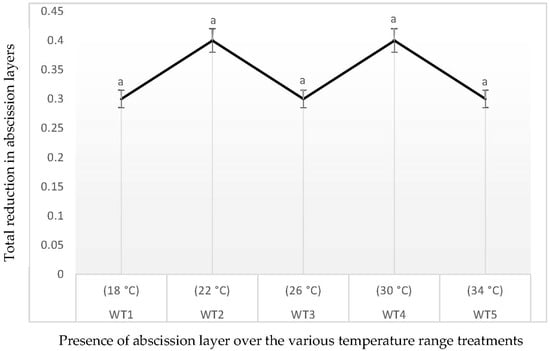
Figure 7.
Root zone heating has the effect of minimizing abscission layers on S. formosus. Note: The line graph presented here depicts means of reduction in abscission layers ± SE. The mean values followed by the same letters are not significantly different (ns) at p ≤ 0.05 as calculated by Fisher’s least significant difference.
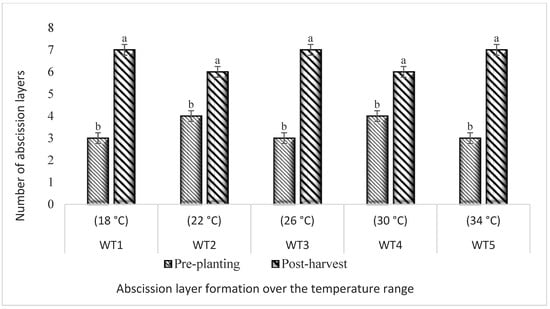
Figure 8.
The correlation between all root zone water temperature treatments and the decrease in abscission layers that were present at the start, as compared to the complete absence of abscission layers at the end of the study. Note: Bar graphs presented here are means of the number of abscission layers ±SE. The mean values followed by the same letters are not significantly different (ns) at p ≤ 0.05 as calculated by Fisher’s least significant difference.

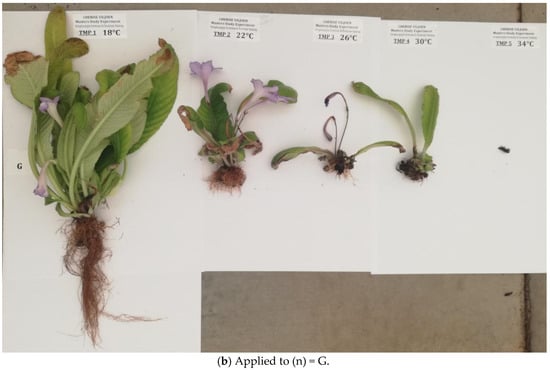
Figure 9.
Postharvest photos display the effect of increasing root zone temperature across the temperature range 18 °C to 34 °C on flower and abscission layer formation on both n = A and n = G (Photos: C. Viljoen).
4. Discussion
High vegetative, flower and fruit yields in quality greenhouse crops are possible with hydroponics due to the precise control of growing conditions and required nutrients [42,52]. Nutrient solution temperature is easily controllable in hydroponics and may be manipulated to control plant growth and maximize the production of plants and flowering during winter periods [11]. Two cultivars of Saintpaulia (Gesneriaceae) subjected to a root zone heating range of 17 °C–25 °C exhibited a 10–15% reduced cultivation time and a significant increase in the rate of flower formation [53]. Root zone heating has shown significant results in herbaceous leafy crops, increasing flower numbers by increasing nutrient uptake [20,48]. Chrysanthemum responded positively when grown in a soilless culture system with a heated solution and produced flowers earlier with optimum results at 24 °C [49]. In woodier crops, such as apple, a root zone temperature of 15 °C proved to be optimal for flowering with a distinct reduction at 30 °C [54], and roses grown in a heated soilless culture system showed an increase in the number of blooms produced over the production season [55].
Streptocarpus formosus responded in various ways to different temperature regimes with a clear trend that resulted in the death of the leaves and roots at higher temperatures (26 °C to 34 °C), with the most optimal growth at the lower temperature of 18 °C. It is also clear that the roots were more sensitive than the shoots. Treatments applied in this investigation had a significant effect on the vegetative root and leaf growth as well as the overall fresh weight of S. formosus. The results obtained from this research disagree with various previous studies which yielded positive results in other leafy perennials and crops at higher temperature ranges such as 24 °C–28 °C for spinach [56]; 25 °C–30 °C for tomatoes and lettuce [20]; 25 °C–45 °C for muskmelon plants [57]; and 15 °C–30 °C, for Chrysanthemum with an optimum temperature of 24 °C [49].
Several other studies performed on soft shrubs, such as roses, indicated that shoot growth was reduced at root temperatures lower than 18 °C [55] and, at this specific temperature or above, heat in the root zone was beneficial [58]. For Euphorbia pulcherrima cuttings, the optimum temperature range for rooting was 25 °C–28 °C [59]. Results for conifer seedlings, such as pine (temperature range 8 °C–20 °C), had significantly new root growth at 20 °C [60]. In [19], the authors showed that lowering the temperature from 21.4 °C to 16.8 °C for Disa spp. had a negative effect on root growth and fresh weight, which agrees with this study where optimum vegetative growth was recorded at root temperatures lower than 18 °C.
The vegetative growth responses of S. formosus in this study contradict the results of research performed on cooler root zone temperature ranges, indicating that lower temperature ranges can restrict photosynthetic, respiration, metabolic and osmotic activities [20,61,62]. However, findings from this study concur with research performed on Streptocarpus hybrid leaf cuttings in the laboratory, which produced the most roots and buds at 12 °C and 18 °C [63], as well as with research performed on cucumbers, where the lowest temperature within the range 22 °C–33 °C yielded the best results [16].
Streptocarpus species only naturally produce flowers during the long-day summer months [3,25]. This study, however, showed that S. formosus was able to produce flower buds during the winter short-day period at lower temperatures. The importance of increasing flowers and regulating the timing of flowering in pot plant production can support the production of the species [61]. As confirmed in Table 3 earlier, the effect of various root zone temperatures on the total flower development of S. formosus was statistically significant at p ≤ 0.05.
In S. formosus, the tips of the leaves often slowly die back to an abscission layer when stressed by drought, low temperature or when overwintered [3]. Growth cessation, abscission formation and dormancy development are considerably affected by temperature [21]. Leaf loss is a strategy for the avoidance of water stress in plant species adapted to drought because it reduces the transpiring surface of the foliage and therefore lessens the water demand [21,22]. Leaf senescence is mainly caused by cold and less commonly by high temperature [5,23]. In winter deciduous species, leaf senescence is an indication of the change from an active to a dormant growth stage [21,64]. When climatic conditions become unfavorable and the plants experience a state of stress, phytohormones react and leaf abscission that can lead to complete senescence is often the result [21]. Some significant abiotic factors affecting leaf abscission are nutrient availability, temperature and water supply [5,21,23], all of which can be managed within hydroponic cultivation systems [17,38]. Ref. [44] recommends that during colder months sub-irrigation should be used with minimal overhead irrigation as water that is considerably colder than the average leaf temperature causes unsightly leaf damage with yellow spots or blotches on Streptocarpus leaves.
In [65], the authors reported that abscission occurred due to short photoperiods in some Streptocarpus spp. In [66], the authors also stated that photoperiod and temperature are the main cues controlling leaf senescence in winter deciduous species, with water stress imposing an additional influence [21]. Although manipulating light and photoperiod could prevent eco-dormancy in S. formosus in the cold season short days, this study, however, proved that manipulating root zone temperature significantly affected the vegetative growth and flower development. A lack of water or nutrients results in leaf yellowing in many plant species, which can be reversed in some species upon removing the stress [6]. In Streptocarpus, it is still possible for the reversal of the formation of the abscission layer and the senescence processes even if the leaves are displaying a distal depletion of chloroplasts [65] if the plants are maintained under conditions of high temperature, nutrient levels and humidity [24]. Leaf senescence can be delayed by warming as photoperiodic triggers and growth proficiency could increase because of a slower speed or prevention of leaf senescence [21,62]. Plant growth can be controlled by the direct correlation between nutrient solution temperatures around the root zone and the uptake of nutrients, with increased plant growth at elevated root temperature correlated with higher nutrient absorption [15,67].
In this study, S. formosus responded in various ways to different root zone temperatures but showed the most significant vegetative mass increases in both shoots and roots at the lower temperature of 18 °C indicating that a low-temperature heating range can be used to keep S. formosus in active growth during the cold season. Treatments applied in this investigation had a significant effect on the flowering formation of S. formosus. Plants responded better to the lower root zone temperatures of 18 °C and 22 °C compared to the higher temperature intervals, and flowers were formed during the colder short-day periods, which indicates a strong possibility that manipulating the growing temperatures could induce S. formosus to flower earlier in the season, thereby increasing its annual commercial marketing period. These findings agree with [49] and [53], in which root zone heating increased blooms and extended the flowering period into the cold season months or encouraged earlier flowering. Moreover, treatments applied in this research also had a significant effect on the abscission layer formation of S. formosus. This indicates that root zone heating is a viable method for preventing the formation of abscission layers.
5. Conclusions
It is concluded that high root-zone temperatures decreased the vegetative growth of S. formosus. The results showed that the cooler root-zone temperature of 18 °C improved growth (leaf number, leaf and root lengths and fresh weight). This study further established that increasing root-zone temperatures did not promote the flowering of S. formosus; however, plants responded positively to flowering at decreased temperatures from 22 °C–18 °C. S. formosus has commercial potential as an indoor flowering pot plant and a flowering landscape perennial, and shows potential within the cut-flower trade. Therefore, these results will contribute to developing optimal cultivation protocols for cultivating Streptocarpus spp. and its hybrids and guide commercial growers in the cultivation of S. formosus in particular.
Author Contributions
Conceptualization, C.C.V. and C.P.L.; Data curation, C.C.V. and M.O.J.; Formal analysis, C.C.V. and M.O.J.; Funding acquisition, C.C.V. and C.P.L.; Investigation, C.C.V.; Methodology, C.C.V. and C.P.L.; Project administration, C.P.L.; Resources, C.C.V. and C.P.L.; Supervision, C.P.L.; Validation, M.O.J. and C.P.L.; Writing—original draft, C.C.V.; Writing—review & editing, C.C.V., M.O.J. and C.P.L. All authors have read and agreed to the published version of the manuscript.
Funding
The study was funded by the South African National Biodiversity Institute.
Institutional Review Board Statement
Not applicable.
Informed Consent Statement
Not applicable.
Data Availability Statement
Data is contained within the article.
Conflicts of Interest
The authors declare no conflict of interest.
References
- Hillard, O.; Burtt, B. Streptocarpus, an African Plant Study; University of Natal Press: Pietermaritzburg, South Africa, 1971. [Google Scholar]
- Otieno, M.; Joshi, N.; Rutschmann, B. Flower visitors of Streptocarpus teitensis: Implications for conservation of a critically endangered African violet species in Kenya. PeerJ 2021, 9, 1–18. [Google Scholar] [CrossRef]
- van der Walt, L. Streptocarpus formosus. Veld Flora 2001, 87, 116–117. [Google Scholar]
- Pooley, E. A field Guide to Wild Flowers Kwazulu-Natal and the Eastern Region; Natal Flora Publications Trust: Durban, South Africa, 1998. [Google Scholar]
- Russo, S.E.; Kitajima, K. The Ecophysiology of Leaf Lifespan in Tropical Forests: Adaptive and Plastic Responses to Environmental Heterogeneity. In Tropical Tree Physiology; Goldstein, G., Santiago, L., Eds.; Springer: Cham, Switzerland, 2016; Volume 6, pp. 357–383. [Google Scholar]
- Van Doorn, W.G.; Woltering, E.J. Senescence and programmed cell death: Substance or semantics? J. Exp. Bot. 2004, 55, 2147–2153. [Google Scholar] [CrossRef] [PubMed]
- Lang, G.; Early, J.; Martin, G.; Darnell, R. Endo-, para-, and ecodormancy: Physiological terminology and classification for dormancy research. HortScience 1987, 22, 371–377. [Google Scholar]
- White, J.W. New and renewed pot plants- Streptocarpus. Pa. Flower Grow. Bull. 1975, 279, 469–472. [Google Scholar]
- Viljoen, C. Streptocarpus Saxorum/Plantz Africa; SANBI: Pretoria, South Africa, 2010. [Google Scholar]
- Blanchard, M.G.; Runkle, E.S. Intermittent light from a rotating high-pressure sodium lamp promotes flowering of long-day plants. HortScience 2010, 45, 236–241. [Google Scholar] [CrossRef]
- Nxawe, S.; Ndakidemi, P.A.; Laubscher, C.P. Possible effects of regulating hydroponic water temperature on plant growth, accumulation of nutrients and other metabolites. Afr. J. Biotechnol. 2010, 9, 9128–9134. [Google Scholar] [CrossRef]
- Sade, N.; Del Mar Rubio-Wilhelmi, M.; Umnajkitikorn, K.; Blumwald, E. Stress-induced senescence and plant tolerance to abiotic stress. J. Exp. Bot. 2018, 69, 845–853. [Google Scholar] [CrossRef]
- Mills, P.J.W.; Smith, I.E.; Marais, G. A greenhouse design for a cool subtropical climate with mild winters based on microclimatic measurements of protected environments. Acta Hortic. 1990, 281, 83–94. [Google Scholar] [CrossRef]
- Avila-Ospina, L.; Moison, M.; Yoshimoto, K.; Masclaux-Daubresse, C. Autophagy, plant senescence, and nutrient recycling. J. Exp. Bot. 2014, 65, 3799–3811. [Google Scholar] [CrossRef]
- Yan, Q.-Y.; Duan, Z.-Q.; Mao, J.-D.; Li, X.; Dong, F. Low Root Zone Temperature Limits Nutrient Effects on Cucumber Seedling Growth and Induces Adversity Physiological Response. J. Integr. Agric. 2013, 12, 1450–1460. [Google Scholar] [CrossRef]
- Al-Rawahy, M.S.; Al-Rawahy, S.A.; Al-Mulla, Y.A.; Nadaf, S.K. Effect of Cooling Root-Zone Temperature on Growth, Yield and Nutrient Uptake in Cucumber Grown in Hydroponic System During Summer Season in Cooled Greenhouse. J. Agric. Sci. 2019, 11. [Google Scholar] [CrossRef]
- Agung, P.P.; Yuliando, H. Soilless Culture System to Support Water Use Efficiency and Product Quality: A Review. Agric. Agric. Sci. Procedia 2015, 3, 283–288. [Google Scholar] [CrossRef]
- Phantong, P.; Machikowa, T.; Saensouk, P.; Muangsan, N. Comparing growth and physiological responses of Globba schomburgkii Hook. f. and Globba marantina L. under hydroponic and soil conditions. Emir. J. Food Agric. 2018, 30. [Google Scholar] [CrossRef]
- Pienaar, D.; Combrink, N.J.J. The effects of N-source, shading and root zone cooling on two Disa hybrids. S. Afr. J. Plant Soil 2007, 24, 166–171. [Google Scholar] [CrossRef]
- Moorby, J.; Graves, C.J. Root and air temperature effects on growth and yield of tomatoes and lettuce. Acta Hortic. 1980, 29–44. [Google Scholar] [CrossRef]
- Estiarte, M.; Penuelas, J. Alteration of the phenology of leaf senescence and fall in winter deciduous species by climate change: Effects on nutrient proficiency. Glob. Chang. Biol. 2015, 21, 1005–1017. [Google Scholar] [CrossRef] [PubMed]
- Kooyers, N.J. The evolution of drought escape and avoidance in natural herbaceous populations. Plant Sci. 2015, 234, 155–162. [Google Scholar] [CrossRef]
- Addicott, F.T. Environmental Factors in the Physiology of Abscission. Plant Physiol. 1968, 43, 1471–1479. [Google Scholar]
- Noel, A.R.A.; van Staden, J. Phyllomorph Senescence in Streptocarpus molweniensis. Ann. Bot. 1975, 39, 921–929. [Google Scholar] [CrossRef]
- Marston, M. The morphology of a Streptocarpus hybrid and its regeneration from leaf cuttings. Sci. Hortic. 1964, 17, 114–120. [Google Scholar]
- Rohde, A.; Bhalerao, R.P. Plant dormancy in the perennial context. Trends Plant Sci. 2007, 12, 217–223. [Google Scholar] [CrossRef]
- Gawadi, A.G.; Avery, G.S. Leaf abscission and the so-called abscission layer. Am. J. Bot. 1950, 37, 172–180. [Google Scholar] [CrossRef]
- Matos, F.S.; Borges, L.P.; Müller, C. Ecophysiology Of Leaf Senescence. Agron. Agric. Sci. 2020, 3, 1–6. [Google Scholar] [CrossRef]
- Dhanasekaran, D.; Jasmine, M. Rooting Behavior of Certain Foliage Ornamentals Grown under Hydroponic Nutrient Solutions. J. Floric. 2019, 21. [Google Scholar]
- Sethi, V.P.; Sharma, S.K. Greenhouse heating and cooling using aquifer water. Energy 2007, 32, 1414–1421. [Google Scholar] [CrossRef]
- Grillas, S.; Lucas, M.; Bardopoulou, E.; Voulgari, M. Perlite based soilless culture systems: Current commercial application and prospects. Acta Hortic. 2001, 548, 105–113. [Google Scholar] [CrossRef]
- Calatayud, Á.; Gorbe, E.; Roca, D.; Martínez, P.F. Effect of two nutrient solution temperatures on nitrate uptake, nitrate reductase activity, NH4+ concentration and chlorophyll a fluorescence in rose plants. Environ. Exp. Bot. 2008, 64, 65–74. [Google Scholar] [CrossRef]
- Van Os, E.A. Recent advances in soilless culture in Europe. Acta Hortic. 2017, 1176, 1–8. [Google Scholar] [CrossRef]
- Asao, T.; Asaduzzaman, M.; Mondal, F.M. Horticultural research in Japan. Production of vegetables and ornamentals in hydroponics, constraints and control measures. Adv. Hortic. Sci. 2014, 28, 167–178. [Google Scholar] [CrossRef]
- Morard, P.; Lacoste, L.; Silvestre, J. Effect of oxygen deficiency on mineral nutrition of excised tomato roots. J. Plant Nutr. 2004, 27, 613–626. [Google Scholar] [CrossRef]
- Boudaghpour, S.; Nasir, K. A study on light expanded clay aggregate (LECA) in a geotechnical view and its application on greenhouse and greenroof cultivation. Int. J. Geol. 2008, 2, 59–63. [Google Scholar]
- Jones, J.B. Complete Guide for Growing Plants Hydroponically; CRS Press, Taylor and Francis Group, LLC: Abingdon, UK, 2014; ISBN 978-1-4398-7668. [Google Scholar]
- Nkcukankcuka, M.; Jimoh, M.O.; Griesel, G.; Laubscher, C.P. Growth characteristics, chlorophyll content and nutrients uptake in Tetragonia decumbens Mill. cultivated under different fertigation regimes in hydroponics. Crop Pasture Sci. 2021, 72, 1–12. [Google Scholar] [CrossRef]
- Sharma, N.; Acharya, S.; Kumar, K.; Singh, N.; Chaurasia, O.P. Hydroponics as an advanced technique for vegetable production: An overview. J. Soil Water Conserv. 2018, 17, 364. [Google Scholar] [CrossRef]
- Adams, P. Crop nutrition in hydroponics. Acta Hortic. 1993, 289–306. [Google Scholar] [CrossRef]
- Kratky, B.A. A suspended pot, non-circulating hydroponic method. Acta Hortic. 2004, 648, 83–89. [Google Scholar] [CrossRef]
- Faber, R.J.; Laubscher, C.P.; Rautenbach, F.; Jimoh, M.O. Variabilities in alkaloid concentration of Sceletium tortuosum (L.) N.E. Br in response to different soilless growing media and fertigation regimes in hydroponics. Heliyon 2020, 6, e05479. [Google Scholar] [CrossRef] [PubMed]
- Martens, D. Back to Basics: Streptocarpus. Gesnariads 2013, 63, 47–50. [Google Scholar]
- Uhl, R. Crop Culture Report: Streptocarpus Ladyslippers Series. Greenh. Prod. News 2012. [Google Scholar]
- Pennisi, B.V. The University of Georgia Cooperative Extension; The University of Georgia: Athens, GA, USA, 2009; p. 28. [Google Scholar]
- Kim, J.H.; Lee, A.K.; Roh, M.S.; Suh, J.K. The effect of irradiance and temperature on the growth and flowering of Sinningia cardinalis. Sci. Hortic. (Amst.) 2015, 194, 147–153. [Google Scholar] [CrossRef]
- World Weather Online Port Saint John’s. Eastern Cape, South Africa Weather Averages|Monthly Average High and Low Temperature|Average Precipitation and Rainfall Days. Available online: https://www.worldweatheronline.com/port-saint-johns-weather-averages/eastern-cape/za.aspx (accessed on 24 March 2021).
- Wang, X.; Zhang, W.; Miao, Y.; Gao, L. Root-Zone Warming Differently Benefits Mature and Newly Unfolded Leaves of Cucumis sativus L. Seedlings under Sub-Optimal Temperature Stress. PLoS ONE 2016, 11, e0155298. [Google Scholar] [CrossRef]
- Morgan, J.; Moustafa, A.; Tan, A. Factors affecting the growing-on stages of lettuce and chrysanthemum in nutrient solution culture. Acta Hortic. 1980, 253–262. [Google Scholar] [CrossRef]
- Jimoh, M.O.; Afolayan, A.J.; Lewu, F.B. Heavy metal uptake and growth characteristics of Amaranthus caudatus L. under five different soils in a controlled environment. Not. Bot. Horti Agrobot. 2020, 48, 417–425. [Google Scholar] [CrossRef]
- Steel, R.G.D.; Torrie, J.H.; Dickey, D.A. Principles and Procedures of Statistics: A Biometrical Approach, 3rd ed.; McGraw-Hill College: Pennsylvania, PA, USA, 1996; ISBN 978-0070610286. [Google Scholar]
- Wahome, P.K.; Oseni, T.; Masarirambi, M. Effects of different hydroponics systems and growing media on the vegetative growth, yield and cut flower quality of gypsophila (Gypsophila paniculata L.). J. Agric. Sci. 2011, 7, 692–698. [Google Scholar]
- Vogelezang, J.V.M. Effect of root-zone heating on growth, flowering and keeping quality of Saintpaulia. Sci. Hortic. (Amst.) 1988, 34, 101–113. [Google Scholar] [CrossRef]
- Greer, D.H.; Wünsche, J.N.; Norling, C.L.; Wiggins, H.N. Root-zone temperatures affect the phenology of bud break, flower cluster development, shoot extension growth and gas exchange of “Braeburn” (Malus domestica) apple trees. Tree Physiol. 2006, 26, 105–111. [Google Scholar] [CrossRef] [PubMed]
- Moss, G.I.; Dalgleish, R. Increasing returns from roses with root-zone warming. J. Am. Soc. Hortic. Sci. 1984, 109, 893–898. [Google Scholar]
- Nxawe, S.; Laubscher, C.P.; Ndakidemi, P.A. Effect of regulated irrigation water temperature on hydroponics production of Spinach (Spinacia oleracea L.). Afr. J. Agric. Res. 2009, 4, 1442–1446. [Google Scholar]
- Stoltzfus, R.M.B.; Taber, H.G.; Aiello, A.S. Effect of increasing root-zone temperature on growth and nutrient uptake by “Gold Star” muskmelon plants. J. Plant Nutr. 1998, 21, 321–328. [Google Scholar] [CrossRef]
- Zeroni, M.; Gale, J. The effect of root temperature on the development, growth and yield of “Sonia” roses. Sci. Hortic. (Amst.) 1982, 18, 177–184. [Google Scholar] [CrossRef]
- Gislerod, H.R. Physical conditions of propagation media and their influence on the rooting of cuttings. Plant Soil 1983, 75, 1–14. [Google Scholar] [CrossRef]
- Andersen, C.P.; Sucoff, E.I.; Dixon, R.K. Effects of root zone temperature on root initiation and elongation in red pine seedlings. Can. J. For. Res. 1986, 16, 696–700. [Google Scholar] [CrossRef]
- Friis, K.; Christensen, O.V. Flowering of Centradenia inaequilateralis “Cascade” as influenced by temperature and photoperiod. Sci. Hortic. (Amst.) 1989, 41, 125–130. [Google Scholar] [CrossRef]
- Norby, R.J.; Hartz-Rubin, J.S.; Verbrugge, M.J. Phenological responses in maple to experimental atmospheric warming and CO2 enrichment. Glob. Chang. Biol. 2003, 9, 1792–1801. [Google Scholar] [CrossRef]
- Appelgren, M.; Heide, O.M. Regeneration in Streptocarpus Leaf Discs and its Regulation by Temperature and Growth Substances. Physiol. Plant 1972, 27, 417–423. [Google Scholar] [CrossRef]
- van Staden, J. Changes in endogenous cytokinin levels during abscission and senescence of Streptocarpus leaves. J. Exp. Bot. 1973, 24, 667–671. [Google Scholar] [CrossRef]
- Scott-Shaw, C.R.; Victor, J.E.; von Staden, L. Streptocarpus formosus (Hilliard & B.L.Burtt) T.J.Edwards; SANBI: Pretoria, South Africa, 2008. [Google Scholar]
- Maurya, J.P.; Bhalerao, R.P. Photoperiod- and temperature-mediated control of growth cessation and dormancy in trees: A molecular perspective. Ann. Bot. 2017, 120, 351–360. [Google Scholar] [CrossRef] [PubMed]
- Adebooye, C.O.; Schmitz-Eiberger, M.; Lankes, C.; Noga, G.J. Inhibitory effects of sub-optimal root zone temperature on leaf bioactive components, photosystem II (PS II) and minerals uptake in Trichosanthes cucumerina L. Cucurbitaceae. Acta Physiol. Plant 2010, 32, 67–73. [Google Scholar] [CrossRef]
Publisher’s Note: MDPI stays neutral with regard to jurisdictional claims in published maps and institutional affiliations All authors have read and agreed to the published version of the manuscript.. |
© 2021 by the authors. Licensee MDPI, Basel, Switzerland. This article is an open access article distributed under the terms and conditions of the Creative Commons Attribution (CC BY) license (https://creativecommons.org/licenses/by/4.0/).